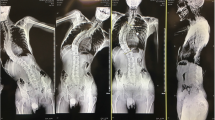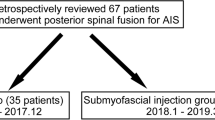Abstract
Purpose
Postoperative pain following scoliosis correction surgery is severe and usually requires prolonged intravenous opioid therapy. Regional anesthesia options are limited and include intrathecal opioid and epidural analgesia; however, they remain little used because of side effects and inconsistent efficacy. We describe a novel multimodal anesthetic regimen incorporating bilateral bi-level erector spinae plane (ESP) blocks together with a combination of several evidence-based intraoperative opioid-sparing analgesic strategies.
Methods
Two healthy young adult patients with idiopathic scoliosis underwent posterior spinal fusion involving 12 vertebral levels (T2–L1 and T3–L2). Bilateral single-injection ESP blocks were performed at two levels (T4 and T10) prior to incision. Intraoperatively, patients received intravenous dexamethasone and infusions of dexmedetomidine and ketamine for multimodal analgesia. Remifentanil was omitted from the total intravenous anesthetic regimen to avoid opioid-induced hyperalgesia.
Results
Both patients had minimal pain on emergence. They transitioned successfully to oral analgesia on the first postoperative day, with modest opioid requirements, no side effects, and low pain scores throughout their hospital stay.
Conclusion
Bilateral bi-level ESP blocks are a simple method of providing pre-emptive regional analgesia in extensive multi-level spine surgery. Integration of ESP blocks into a multimodal regimen that employs other opioid-sparing strategies may have additive, and potentially synergistic, benefits in improving postoperative analgesia and reducing opioid requirements.




Similar content being viewed by others
References
Kwan MK, Chiu CK, Chan TS et al (2017) Trajectory of postoperative wound pain within the first 2 weeks following posterior spinal fusion surgery in adolescent idiopathic scoliosis patients. Spine 42:838–843
Hiller A, Helenius I, Nurmi E et al (2012) Acetaminophen improves analgesia but does not reduce opioid requirement after major spine surgery in children and adolescents. Spine 37:E1225–E1231
Tripi PA, Poe-Kochert C, Potzman J, Son-Hing JP, Thompson GH (2008) Intrathecal morphine for postoperative analgesia in patients with idiopathic scoliosis undergoing posterior spinal fusion. Spine 33:2248–2251
Hong RA, Gibbons KM, Li GY, Holman A, Voepel-Lewis T (2017) A retrospective comparison of intrathecal morphine and epidural hydromorphone for analgesia following posterior spinal fusion in adolescents with idiopathic scoliosis. Paediatr Anaesth 27:91–97
Taenzer AH, Clark C (2010) Efficacy of postoperative epidural analgesia in adolescent scoliosis surgery: a meta-analysis. Paediatr Anaesth 20:135–143
Klatt JWB, Mickelson J, Hung M, Durcan S, Miller C, Smith JT (2013) A randomized prospective evaluation of 3 techniques of postoperative pain management after posterior spinal instrumentation and fusion. Spine 38:1626–1631
Forero M, Adhikary SD, Lopez H, Tsui C, Chin KJ (2016) The erector spinae plane block: a novel analgesic technique in thoracic neuropathic pain. Reg Anesth Pain Med 41:621–627
Chin KJ, Adhikary S, Sarwani N, Forero M (2017) The analgesic efficacy of pre-operative bilateral erector spinae plane (ESP) blocks in patients having ventral hernia repair. Anaesthesia 72:452–460
Melvin JP, Schrot RJ, Chu GM, Chin KJ (2018) Low thoracic erector spinae plane block for perioperative analgesia in lumbosacral spine surgery: a case series. Can J Anaesth 65:1057–1065
Ivanusic J, Konishi Y, Barrington MJ (2018) A cadaveric study investigating the mechanism of action of erector spinae blockade. Reg Anesth Pain Med 43:567–571
Yang H-M, Choi YJ, Kwon H-J, O J, Cho TH, Kim SH (2018) Comparison of injectate spread and nerve involvement between retrolaminar and erector spinae plane blocks in the thoracic region: a cadaveric study. Anaesthesia 73:1244–1250
Chin KJ, Lewis S (2019) Opioid-free analgesia for posterior spinal fusion surgery using erector spinae plane (ESP) blocks in a multimodal anesthetic regimen. Spine 44:E379–E383
Sharma S, Balireddy RK, Vorenkamp KE, Durieux ME (2012) Beyond opioid patient-controlled analgesia: a systematic review of analgesia after major spine surgery. Reg Anesth Pain Med 37:79–98
Loftus RW, Yeager MP, Clark JA et al (2010) Intraoperative ketamine reduces perioperative opiate consumption in opiate-dependent patients with chronic back pain undergoing back surgery. Anesthesiology 113:639–646
Hwang W, Lee J, Park J, Joo J (2015) Dexmedetomidine versus remifentanil in postoperative pain control after spinal surgery: a randomized controlled study. BMC Anesthesiol 15:21
Garg N, Panda NB, Gandhi KA et al (2016) Comparison of small dose ketamine and dexmedetomidine infusion for postoperative analgesia in spine surgery: a prospective randomized double-blind placebo controlled study. J Neurosurg Anesthesiol 28:27–31
Perera AP, Chari A, Kostusiak M, Khan AA, Luoma AM, Casey ATH (2017) Intramuscular local anesthetic infiltration at closure for postoperative analgesia in lumbar spine surgery: a systematic review and meta-analysis. Spine 42:1088–1095
Adhikary SD, Bernard S, Lopez H, Chin KJ (2018) Erector spinae plane block versus retrolaminar block: a magnetic resonance imaging and anatomical study. Reg Anesth Pain Med 43:756–762
Kelly DJ, Ahmad M, Brull SJ (2001) Preemptive analgesia I: physiological pathways and pharmacological modalities. Can J Anaesth 48:1000–1010
Katz J, Clarke H, Seltzer Z (2011) Review article: preventive analgesia: quo vadimus? Anesth Analg 113:1242–1253
Vidal E, Giménez H, Forero M, Fajardo M (2018) Erector spinae plane block: a cadaver study to determine its mechanism of action. Rev Esp Anestesiol Reanim 65:514–519
Tulgar S, Selvi O, Senturk O, Serifsoy TE, Thomas DT (2019) Ultrasound-guided erector spinae plane block: indications, complications, and effects on acute and chronic pain based on a single-center experience. Cureus 11:e3815
Cuvillon P, Nouvellon E, Ripart J et al (2009) A comparison of the pharmacodynamics and pharmacokinetics of bupivacaine, ropivacaine (with epinephrine) and their equal volume mixtures with lidocaine used for femoral and sciatic nerve blocks: a double-blind randomized study. Anesth Analg 108:641–649
Krishna SN, Chauhan S, Bhoi D et al (2019) Bilateral erector spinae plane block for acute post-surgical pain in adult cardiac surgical patients: a randomized controlled trial. J Cardiothorac Vasc Anesth 33:368–375
Mathiesen O, Dahl B, Thomsen BA et al (2013) A comprehensive multimodal pain treatment reduces opioid consumption after multilevel spine surgery. Eur Spine J 22:2089–2096
Lee BH, Park J-O, Suk K-S et al (2013) Pre-emptive and multi-modal perioperative pain management may improve quality of life in patients undergoing spinal surgery. Pain Physician 16:E217–226
Abdallah FW, Dwyer T, Chan VWS et al (2016) IV and perineural dexmedetomidine similarly prolong the duration of analgesia after interscalene brachial plexus block: a randomized, three-arm, triple-masked placebo-controlled. Trial Anesthesiol 124:683–695
Pehora C, Pearson AM, Kaushal A, Crawford MW, Johnston B (2017) Dexamethasone as an adjuvant to peripheral nerve block. Cochrane Database Syst Rev 11:CD011770
Kang R, Jeong JS, Yoo JC et al (2019) Improvement in postoperative pain control by combined use of intravenous dexamethasone with intravenous dexmedetomidine after interscalene brachial plexus block for arthroscopic shoulder surgery: a randomised controlled trial. Eur J Anaesthesiol 36(5):360–368
Waldron NH, Jones CA, Gan TJ, Allen TK, Habib AS (2013) Impact of perioperative dexamethasone on postoperative analgesia and side-effects: systematic review and meta-analysis. Br J Anaesth 110:191–200
Schnabel A, Reichl SU, Poepping DM, Kranke P, Pogatzki-Zahn EM, Zahn PK (2013) Efficacy and safety of intraoperative dexmedetomidine for acute postoperative pain in children: a meta-analysis of randomized controlled trials. Paediatr Anaesth 23:170–179
Tonner PH (2017) Additives used to reduce perioperative opioid consumption 1: alpha2-agonists. Best Pract Res Clin Anaesthesiol 31:505–512
Fletcher D, Martinez V (2014) Opioid-induced hyperalgesia in patients after surgery: a systematic review and a meta-analysis. Br J Anaesth 112:991–1004
Schwenk ES, Viscusi ER, Buvanendran A et al (2018) Consensus guidelines on the use of intravenous ketamine infusions for acute pain management from the American Society of Regional Anesthesia and Pain Medicine, the American Academy of Pain Medicine, and the American Society of Anesthesiologists. Reg Anesth Pain Med 43:456–466
Funding
Dr Ki Jinn Chin is supported by a Merit Award from the Department of Anesthesia, University of Toronto.
Author information
Authors and Affiliations
Corresponding author
Ethics declarations
Conflicts of interest
The authors declare no conflicts of interest.
Additional information
Publisher's Note
Springer Nature remains neutral with regard to jurisdictional claims in published maps and institutional affiliations.
Rights and permissions
About this article
Cite this article
Chin, K.J., Dinsmore, M.J., Lewis, S. et al. Opioid-sparing multimodal analgesia with bilateral bi-level erector spinae plane blocks in scoliosis surgery: a case report of two patients. Eur Spine J 29 (Suppl 2), 138–144 (2020). https://doi.org/10.1007/s00586-019-06133-8
Received:
Revised:
Accepted:
Published:
Issue Date:
DOI: https://doi.org/10.1007/s00586-019-06133-8




